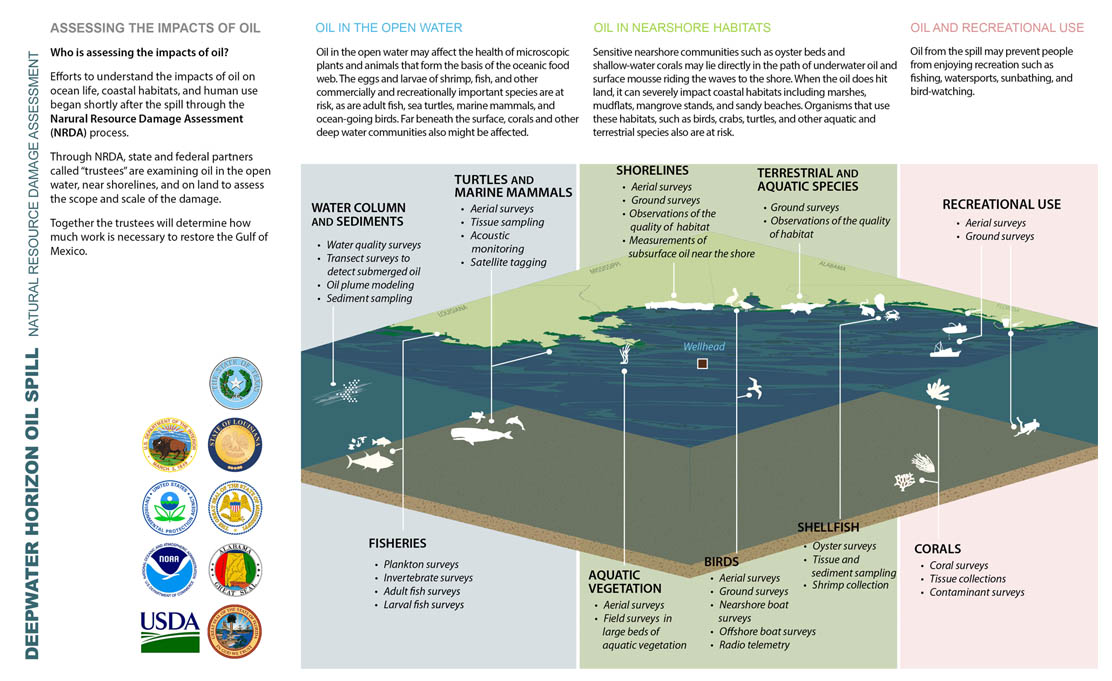
Based on past research and assessments of previous spills, we know that oil and toxins in oil can harm many kinds of organisms. Oil can kill organisms or have effects on future generations. Potential long-term harmful effects include genetic damage, liver disease, cancer, and impairment of reproductive, developmental, and immune systems.
We conducted hundreds of scientific studies to determine whether there have been negative effects from Deepwater Horizon oil. We conducted these studies in a variety of Gulf habitats, including deep sea sediments, water column, nearshore, and shoreline habitat. We also studied a variety of wildlife, including fish, marine mammals, sea turtles, shellfish, corals, and birds. Data collection efforts were completed in 2015, but monitoring is ongoing. The work plans for these studies and data are available in the Administrative Record Index for the Deepwater Horizon Natural Resource Damage Assessment.
Below are examples of studies we commissioned.
- Marine mammals and sea turtles
-
Image
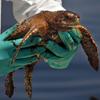
Mammals studied included whales, manatees, and dolphins. Investigations included:
- aerial surveys
- satellite tagging, tracking, and monitoring
- tissue collection and analysis
- collection and analyses of prey species
For example, sea turtle studies looked at factors such as species locations, distribution, nesting habits, and habitat preferences to assess potential exposure to oil. They also included taking blood and other tissue samples for chemical and toxicological analyses as well as evaluating nesting rates on Gulf beaches.
- Fish and shellfish
-
Image
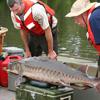 These studies included collection of specimens to determine distribution and abundance of fish populations, and the collection of tissue samples for toxicological and other analyses. Water and sediment samples were also taken from the areas where these species were collected.
These studies included collection of specimens to determine distribution and abundance of fish populations, and the collection of tissue samples for toxicological and other analyses. Water and sediment samples were also taken from the areas where these species were collected. - Birds
-
Image
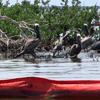
Studies of birds included efforts such as:
- aerial photography of bird nesting colonies at the time of the spill and in subsequent nesting seasons
- documenting oiled and non-oiled bird numbers
- estimating the number of birds killed
- Deep water habitat
-
Image
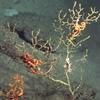 Studies included sampling water and sediment for the presence of oil near deep reef communities. We also took tissue samples from deep water organisms. Surveys were taken to quantify the biodiversity, distribution, and abundance of deep-sea wildlife via video and photographs taken at the well head on the sea floor.
Studies included sampling water and sediment for the presence of oil near deep reef communities. We also took tissue samples from deep water organisms. Surveys were taken to quantify the biodiversity, distribution, and abundance of deep-sea wildlife via video and photographs taken at the well head on the sea floor. - Intertidal and near shore sub-tidal habitats (including seagrasses, mud flats, coral reefs)
-
Image
 Many of these studies included sampling to determine whether submerged aquatic vegetation, which provide habitat for waterfowl and fish, were exposed to oil. We mapped these areas and documented species composition.
Many of these studies included sampling to determine whether submerged aquatic vegetation, which provide habitat for waterfowl and fish, were exposed to oil. We mapped these areas and documented species composition. - Shoreline habitats (including salt marsh, beaches, mangroves)
-
Image
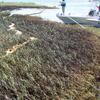 These studies included sampling and monitoring of vegetation that was exposed or potentially exposed to oil. We also determined contaminant levels in animals living in or on bottom sediments.
These studies included sampling and monitoring of vegetation that was exposed or potentially exposed to oil. We also determined contaminant levels in animals living in or on bottom sediments. - Human uses of natural resources (e.g., recreational fishing, boating, shoreline recreation, subsistence, cultural uses, etc.
-
Image
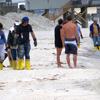 These studies assessed impacts to human use, including collecting data on shoreline visitation numbers. We collected this data via aerial and ground surveys and interviews of people on the beach. We also used economic analysis to assess impacts of the oil spill to recreational use.
These studies assessed impacts to human use, including collecting data on shoreline visitation numbers. We collected this data via aerial and ground surveys and interviews of people on the beach. We also used economic analysis to assess impacts of the oil spill to recreational use.

